The true cost of fossil fuels
What the science says...
When you account for the effects which are not reflected in the market price of fossil fuels, like air pollution and health impacts, the true cost of coal and other fossil fuels is higher than the cost of most renewable energy technologies.
Climate Myth...
Renewable energy is too expensive
"[Wind energy] is a more expensive way of producing energy than the alternative." (David Montgomery)
Due to its abundance and low market price, coal combustion is the largest source of energy production in the world, accounting for 40% of all electricity worldwide. In the USA it accounts for 45% of electricity generation, and approximately 75% in Australia.
Unfortunately, coal combustion is a major contributor to global greenhouse gas emissions as well, accounting for 30% of total anthropogenic carbon dioxide (CO2) emissions worldwide, and 72% of CO2 emissions from global power generation. In addition, non-power generation uses increase its contribution to global human CO2 emissions to a whopping 41% (as of 2005).
Many people prefer coal combustion to renewable energy because it seems to be cheaper. However, when accounting for the true costs of coal power, most renewable energy sources are actually significantly cheaper in the long-run.
Coal Externalities
A major problem with coal is that its full costs are not reflected in its market price, and thus while we may seemingly purchase and burn coal cheaply, in reality we are paying a much higher cost in the long run, if we look at the big picture. Economists refer to the impacts on human and environmental health which are not reflected in the price of coal as "externalities". Those who benefit from the seemingly cheap electricity don't pay for these externalities directly, but the public eventually has to pay in the form of medical bills, environmental cleanups, etc.
A 2013 report published by the International Monetary Fund concluded that global fossil fuel subisides amount to $1.9 trillion annually. $1.4 trillion of this is due to externalities, $800 billion due to climate change. This estimate is based on a conservative social cost of carbon of $25 per tonne of CO2 emitted. An arguably more realistic estimate of $100 per tonne of CO2 would bring global fossil fuel subsidies to over $4 trillion per year, with $3.2 trillion due to climate change.
In a report published in the Annals of the New York Academy of Sciences, Epstein et al. (2011) do a full cost accounting for the life cycle of coal, taking these externalities into account. Among the factors included in this analysis were:
- government coal subsidies
- increased illness and mortality due to mining pollution
- climate change from greenhouse gas emissions
- particulates causing air pollution
- loss of biodiversity
- cost to taxpayers of environmental monitoring and cleanup
- decreased property values
- infrastructure damages from mudslides resulting from mountaintop removal
- infrastructure damage from mine blasting
- impacts of acid rain resulting from coal combustion byproducts
- water pollution
Most of these external factors do not apply to most renewable energy sources. The majority of the externality costs come from reduction in air quality, contribution to climate change, and impacts to public health. Epstein et al. find that the total cost of these externalities ranges from approximately 9 to 27 cents per kilowatt-hour (kWh) of electricity generated, with a median of approximately 18 cents per kWh. The authors note that this is a conservative estimate, because they have not accounted for every associated impact.
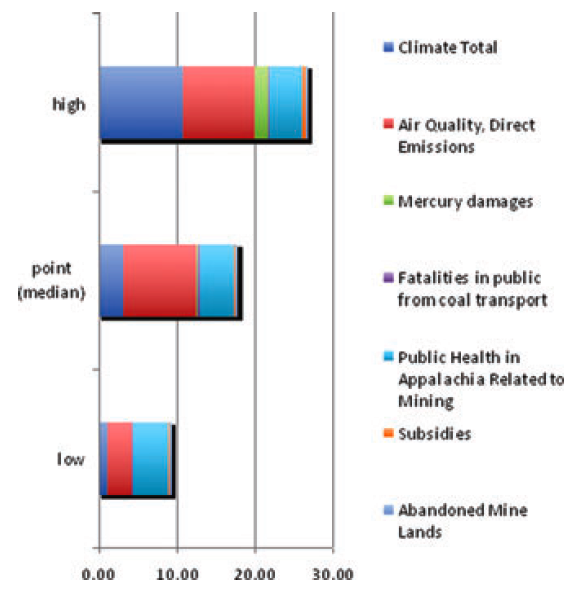
Figure 1: Coal externalized cost (cents per kWh) from Epstein et al. (2011)
Another study by economists Muller, Mendelsohn, and Norhaus (MMN11) looked at just the external costs associated with the damage done by air pollution, and arrived at a best estimate of 3.6 cents per kWh of external costs, despite being unrealistically conservative (Figure 2).
Figure 2: Average US coal electricity price vs. MMN11 and Epstein 2001 best estimate coal external costs.
Cost Comparison
The US Energy Information Administration provides a comparison of levelized costs for different power generation sources. Levelized cost represents the present value of the total cost of building and operating a generating plant over a period of time, and reflects overnight capital cost, fuel cost, operation and maintenance costs, financing costs, and an assumed utilization rate for each plant type. To convert from dollars per megawatt-hour to cents per kWh, move the decimal point in the table below one spot to the left (for example, conventional coal is 9.48 cents per kWh on average).
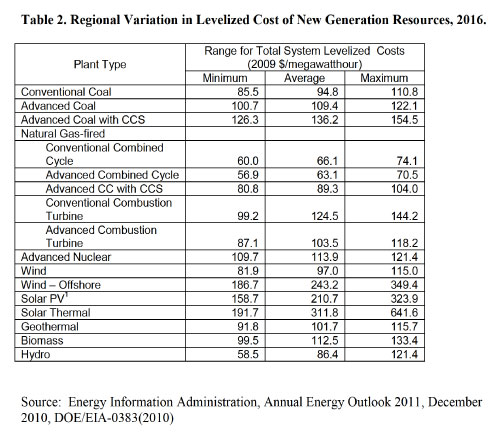
As you can see, the externalities are sufficient to triple the cost of coal power, if they were reflected in its price. If we include the coal externalities, it increases the levalized costs to approximately 18 to 28 cents per kWh, which is more than hydroelectric, onshore wind, geothermal, biomass, nuclear, natural gas, and on par with solar photovoltaic and solar thermal (whose costs are falling rapidly), and offshore wind. Suddenly coal doesn't look like such a good deal.
Recommendations
Epstein et al. conclude by offering a number of recommendations:
-
Comprehensive comparative analyses of life cycle costs of all electricity generation technologies and practices are needed to guide the development of future energy policies.
-
Begin phasing out coal and phasing in cleanly powered smart grids, using place-appropriate alternative energy sources.
-
A healthy energy future can include electric vehicles, plugged into cleanly powered smart grids; and healthy cities initiatives, including green buildings, roof-top gardens, public transport, and smart growth.
-
Alternative industrial and farming policies are needed for coal-field regions, to support the manufacture and installation of solar, wind, small-scale hydro, and smart grid technologies. Rural electric co-ops can help in meeting consumer demands.
-
We must end mountaintop removal (MTR) mining, reclaim all MTR sites and abandoned mine lands, and ensure that local water sources are safe for consumption.
-
Funds are needed for clean enterprises, reclamation, and water treatment.
-
Fund-generating methods include: maintaining revenues from the workers’ compensation coal tax; increasing coal severance tax rates; increasing fees on coal haul trucks and trains; reforming the structure of credits and taxes to remove misaligned incentives; reforming federal and state subsidies to incentivize clean technology infrastructure.
-
To transform our energy infrastructure, we must realign federal and state rules, regulations, and rewards to stimulate manufacturing of and markets for clean and efficient energy systems. Such a transformation would be beneficial for our health, for the environment, for sustained economic health, and would contribute to stabilizing the global climate.
Real World Data
In the USA, there is no correlation between state renewable electricity production and electricity price (Figure 3) or renewable production and electricity price increase over the past two decades (Figure 4).
Figure 3: State renewable (excluding hydroelectricity) electricity percentage of total electricity generation vs. electricity price (blue diamonds) with a linear trend (black line). Data from EIA (here and here).
Figure 4: State renewable (excluding hydroelectricity) electricity percentage of total electricity generation vs. the percent annual increase in electricity price 1990—2011 (blue diamonds) with a linear trend (black line). Data from EIA (here and here).
If deploying renewable energy does not raise electricity prices, then clearly it is not an expensive proposition.
Bottom Line
Ultimately it's a significant problem that we rely so heavily on coal to meet our energy needs due to its artificially low market price. It's like eating junk food for every meal. It's cheap, it tastes good, but it's not healthy and eventually you'll pay the price through poor health, high medical bills, and a shortened lifespan.
We may not pay the costs of climate change, lost biodiversity, air and water pollution, adverse health effects, etc. up front, but we do have to pay them eventually. We need to follow the recommendations of Epstein et al., transform our energy infrastructure, and move away from our dependence on coal and other fossil fuels.
Last updated on 14 July 2018 by dana1981. View Archives































 Arguments
Arguments























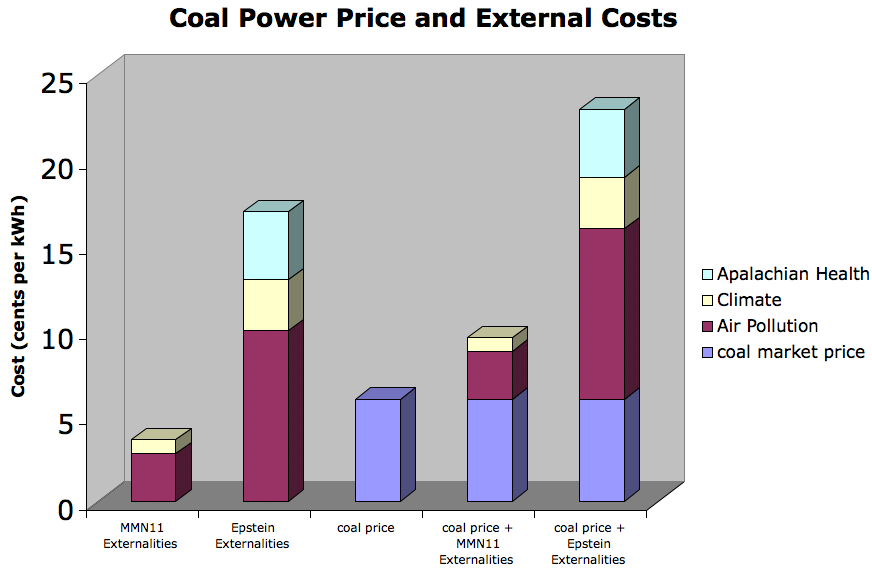
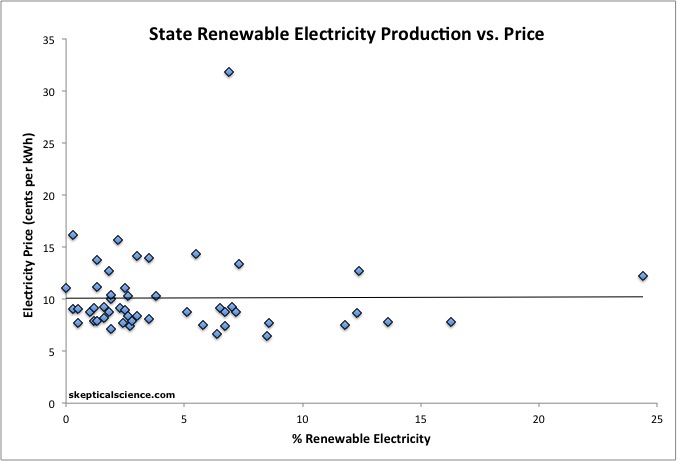
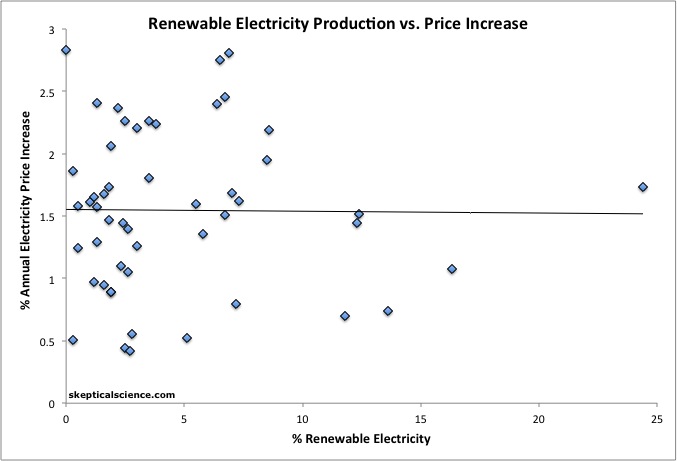







CORRECTION @24 :
I need a better brain and better envelope.
The (Wiki-based) figures I gave as 10% of cultivated land biomass annual production, would need 100% mass conversion "in the factory" ~ and would approximately match world gasoline consumption. To additionally match diesel & jetfuel usage, would need an additional 15% on top of that 10% of cultivated biomass. (The cultivated biomass here uses the whole plant hydrocarbon resource, excluding the edible section of the crop. Also excluded is forestry biomass harvest.)
So roughly 25% of cropped land, excluding trees. Formidable: and high-tech required too. Solar, wind, and nuclear fission/fusion . . . can't come soon enough.
Max Green,
This argument against renewables is very old. It was originally raised around 2005. Mark Jacobson and his team at Stanford did a detailed Peer-Reviewed analysis that showed that all the materials for a compeltely renewable energy system were available except for rare earth metals needed for the wind turbines. Since then, wind turbines have been developed that do not use rare earth elements in their turbines. In addition, the manufacture of wind turbines and solar panels have become much more efficient that Jacobson estimated so that even less metal will be used. I note that large amounts of metal are now being used to drill for fossil fuels.
Reading your popuilar magazine article I see that the Simon Michaux reference is just to a seminar he presented, not even a conference poster. Seminars are sim[ply his opinion of things he has no experience in, unreviewed by anyone. He states that a lot of materials are needed. For one thing he calculates that:
"Globally, 15,635,478 Hornsdale-type stations will need to be built across the planet and connected to the power grid system just to meet a 4-week buffer system"
Jacobson et al 2022 in an extermely detailed, peer reviewed analysis, finds that only 4-8 hours of buffer system are required. Other energy researchers find similar results as Jacobson. Why should I pay attention to an unreviewed talk to graduate students by someone who has no experience with the topic and that calculates 150 times more storage than the peer reviewed literature?
If you look at all the materials needed for a total renewable energy system in the future there are issues with some materials. If you do the same calculation for a fossil system there are some materials that will run out. If you demand 100 times the required materials for the renewable system than are actually needed than it makes the renewable system look bad.
Simon Michaux is simply full of BS.
This was a post that I just read last night. I told the poster I had read up on the gas turbines and there effiency. I asked if he couId produce a paper because I thought there were facts he had probably not included. I refered him the the Anderson Economic study where some cherry picking had been done. He said I was math deficient and that anyone with even moderate math skills should be able to come to the conclusion.
[BL] As noted further down in comment #31, stranger1548 failed to make it clear that only the first paragraph is his/her writing, and the rest is a quote from a "skeptic". All but the first paragraph has been modified to be indented, to help clarify this.
[No, you can't edit your own comments.]
stranger1548 @28... More thorough peer reviewed work on this subject is available, so there's really no need to do this kind of back-of-the-napkin estimate. And when doing this kind of thin analysis it's certainly no justification for making definitive assertions such as your final sentence here.
Here's one study saying, yes, EV's are more efficient WTW (well to wheel) but not significantly. Although, they add, if you include electricity from renewable resources, which nearly all grids now increasingly include, EV's are up to 70% efficient.
https://sciendo.com/downloadpdf/journals/rtuect/24/1/article-p669.pdf
When I look at other WTW analyses, most aren't even comparing ICEV's to EV's. They're comparing HFCV's (hydrogen fuel cell) to BEV's. Internal combustion isn't even in the running.
https://enveurope.springeropen.com/articles/10.1186/2190-4715-24-14
If you think the available research is getting the results in error, it is incumbent upon you to also publish your results in a reputable journal. That'll require a lot more napkins.
Stranger1548,
As Rob Honeycutt says doing your own calcualtions is usually a waste of time.
This Carbon Brief article finds that comparing the most inefficient coal plants electricity to the most efficient ICE car on the road (Toyota Prius ECO) that the life time emissions of CO2 are about the same. With partial renewableenergy the electric car is better. Compared to less efficient cars the electric cars are much better. Once all electricity is renewable the electric cars will be much more efficient.
There must be a number of errors in your estimate. For one, you use the gasoline at the time it is burned while the electricity has to be transmitted and charged. The gasoline does not magically appear at the gas station, about 10% of the embodied energy is used for mining, refining and transporting it to the gas station.
Sorry for the confusion! I forgot put in the quote marks. The first paragraph is what I wrote. The rest was the skeptics claim.
Ah, that makes more sense, stranger1548. I was trying to reconcile the two and defaulted to the latter half as what you were claiming. There are a bunch of formatting functions in the text editing box that you can use to differentiate your words from others. I tend to utilize the...
I came across a recent substack post by Energy Bad Boys, EBB, claiming that wind and solar make for expensive electricity. They used a very limited example of California and their home state of Minnesota to make that claim. I countered with Iowa and South Dakota that have very high percentages of wind and cheaper electricity, which they dismissed.
This motivated a more complete analysis using data from EIA, EIA electricity data browser , for 2022 for all 48 contiguous states comparing average retail electricity prices to the percentage of renewable electricity generation - wind plus all solar, i.e., utility solar plus small solar. The data for 2022 extends the percentage of renewables out to greater than 60%, Hosted images . (Sorry, I could not get the image insert function to work.)
The conclusion is still the same. There is no correlation between state electricity prices and percentage of renewables. If anything there is a slight trend towards lower prices with increased penetration.
[BL] The ability to insert images is limited to images that are on a publicly-available server with a direct URL to the image. Your "hosted images" link goes to a Google page, not a stand-alone image. This site does not cache or store a copy of the image - it will only be visible as long as the original on the external site is still available.
It looks like Google does not allow such linking and display, even if you use the link that leads to the image only.
I have now posted a reply to the Energy Bad Boys, EBB , with references to my Notes at Substack that include graphics. Here is a copy of that reply.
--------------------
A thorough review of electricity prices for the 48 contiguous states suggests that there is no correlation between increased use of wind and solar and higher electricity prices. If anything, the opposite appears to be true.
Using data available at the EIA electricity data browser, a comparison of the increase in average electricity prices from 2002 to 2022 for the contiguous U.S. as a function of the percentage of renewable electricity generated suggests that more renewables lead to lower electricity prices, not higher.
Note1
A comparison of the retail price of electricity for 2022 for the 48 states as a function of percentage of renewable electricity also shows a similar trend, states with more renewables tend to have lower electricity prices.
Note2
------------------